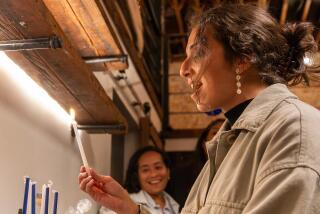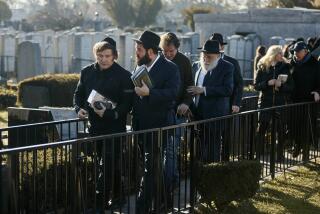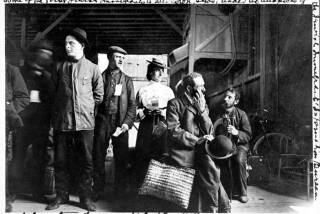Tiny Island Is Home to 1st Jewish Roots in the New World : History: Sephardic Jews who settled on Curacao in the 1600s founded the oldest synagogue in the Americas.
WILLEMSTAD, CURACAO, Netherlands Antilles — This tiny Dutch Caribbean island 35 miles off the coast of Venezuela is the cradle of the Jewish faith in the New World, drawing Jews on pilgrimages from throughout the United States, Canada, Mexico and Central and South America.
They come to see the 262-year-old Mikve Israel-Emanuel Synagogue, and worship with descendants of the Jewish families who first moved to this tiny, remote island almost 350 years ago from Holland to establish an agricultural colony called De Hoop (Hope).
The Sephardic Jewish community here is the oldest Jewish congregation in the Western Hemisphere, and its synagogue the oldest in the Americas.
“There are 350 Sephardic Jews, like myself, whose families date back to the 1600s, living on this tropical island,” said Rene D.L. Maduro, 54, a management consultant and president of the Mikve Israel-Emanuel Synagogue Foundation.
The ancestors of Curacao’s Jews were driven from Spain to Portugal during the Inquisition of 1492. They spent 100 years there, and when the Inquisition began in Portugal, they moved to the Netherlands, where they were accepted by the Dutch Protestants.
Once in Curacao, “the Jews planted sugar cane, corn and other crops . . . [but] the farms failed,” Maduro said. “But the Jews soon prospered as merchants and Curacao became the Caribbean center for much of the trading between Europe and the American colonies.”
In 1659, a second group of Sephardic Jews arrived from Holland, including 50 families with more than 200 men, women and children. By 1674, they had built Curacao’s first synagogue.
By the time the present synagogue was built in 1732, there were 2,000 Jews and 2,000 Dutch Protestants living on Curacao.
The first synagogue contains a Torah scroll, brought to the island by the first Jewish settlers, that dates back to 1492, the year of the expulsion of Jews from Spain.
The opening prayer for every service--as has been the custom for 262 years--is a prayer for the well-being of the Dutch royal family.
“When the Netherlands agreed to accept the Sephardic Jews banished from Spain and Portugal, our people promised that from that time on, the first prayer at every religious service would always be a prayer for the royal family. The tradition continues to this day,” Maduro said.
Even today, the ground floor and balconies of the temple are covered with a two-inch layer of fine sand, “to remind us of our past,” Maduro said.
“The sand has three symbolic meanings: for the Jews wandering in the desert 40 years; to remember when our forefathers in Spain and Portugal held secret religious services in their homes, with sand on the floor to muffle the sounds, and [in tribute to] God’s promise to Abraham that his descendants would be as numerous as the sands of the seashores.”
During the past three centuries, hundreds of Sephardic Jews have migrated from Curacao to Venezuela, Cuba, Panama and Jamaica. And many of the descendants of the Dutch Jews who sailed to Curacao in the 1600s now live in the United States, primarily in New York City, Savannah, Ga., and Rhode Island.
Rabbi Isaac de Touro and 13 Jewish families from Curacao immigrated to Rhode Island in 1658 and built the Touro Synagogue in Newport in 1763, making it this country’s oldest standing synagogue.
Today, Curacao’s Jewish population is diminishing; one of every two Sephardic Jews born on the island migrates to another country. Many of the young Jews raised on the island attend college in the United States or Europe, Maduro said. “where they fall in love, marry an off-islander and never return.”
More to Read
Sign up for Essential California
The most important California stories and recommendations in your inbox every morning.
You may occasionally receive promotional content from the Los Angeles Times.










